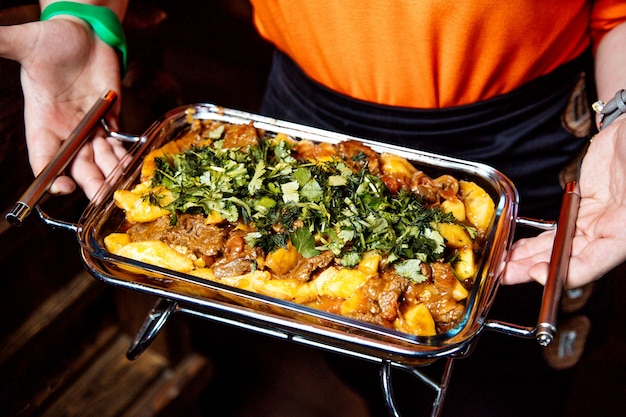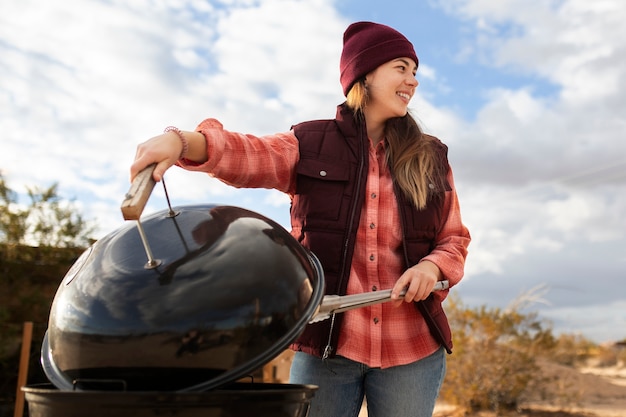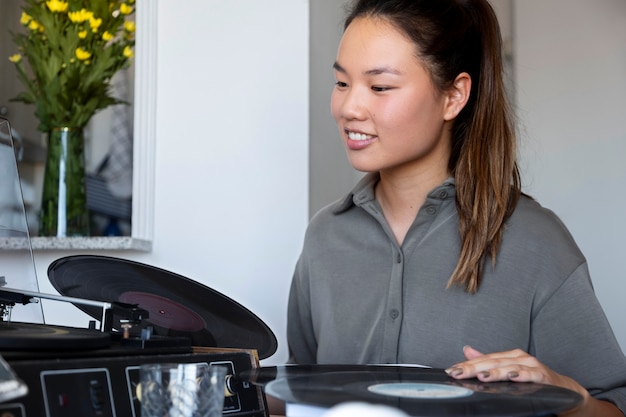(Part 1) The Dutch Oven: A Kitchen Essential

First, let's get the name straight. "Dutch oven" might sound a bit misleading, because these beauties are anything but limited to Dutch cuisine. You'll find them in kitchens all over the world, and for good reason.
What makes them so special? It's a combination of features that work together to create a culinary powerhouse. You've got the sturdy construction, usually made from cast iron or enameled cast iron. This heavy-duty material is key to even heat distribution. No more hot spots, no more burning your food. It's all about that perfect, consistent cooking experience.
Then there's the tight-fitting lid. It traps moisture and heat, creating a wonderful little oven environment inside your pot. This is ideal for slow cooking, braising, and even baking. Think rich stews, tender roasts, and fluffy loaves of bread. The possibilities are truly endless.
(Part 2) The Versatility of a Dutch Oven

Now, I know you're probably thinking: "Okay, it sounds good, but what can I actually make with it?" Don't worry, I've got you covered.
2.1 From Stews to Breads: A Culinary Chameleon
The Dutch oven is a true multitasker. One day you're simmering a hearty stew, the next you're baking a beautiful loaf of bread. It's like having a mini oven right on your stovetop.
I love making slow-cooked stews in my Dutch oven. The long, gentle cooking process allows all those flavors to meld together beautifully. It's a real comfort food, perfect for chilly evenings.
But don't stop at stews! You can also use your Dutch oven for:
- Braising: Tenderising tough cuts of meat is a breeze. The Dutch oven does all the work for you. You'll be surprised at how succulent even the most challenging cuts can become.
- Roasting: Get that crispy skin on your chicken or pork roast. The Dutch oven creates a perfect environment for even roasting, ensuring a perfectly cooked meal.
- Soup: Make a big pot of soup and keep it warm all day. It's perfect for parties or simply having delicious soup on hand for days.
- Chilis: The perfect vessel for simmering a rich and flavorful chili. You'll be able to create a chili that's deeply satisfying and full of flavour.
- Casseroles: Make delicious one-pot meals that are perfect for a busy weeknight. It's the ideal solution for those nights when you need something quick and easy.
2.2 Beyond the Stovetop: The Oven's Best Friend
And get this, it's not just for the stovetop. You can also use your Dutch oven in the oven! That's right, you can bake bread, cakes, and even pies in it. This versatility makes it an incredibly useful tool for any home cook.
I've got a delicious recipe for a Dutch oven bread that I'm dying to share with you. It's so easy to make, and the bread comes out beautifully browned and fluffy. It's a real crowd-pleaser, and the aroma that fills your kitchen while it's baking is simply irresistible.
2.3 The Benefits: More Than Just a Pot
Let's face it, cooking can sometimes be a chore. But the Dutch oven makes it a little bit more enjoyable. It's a bit of a culinary magic trick.
Here’s why I love using a Dutch oven:
- Even Cooking: No more hot spots, your food cooks evenly every time. Say goodbye to overcooked parts and undercooked parts. It's all about consistent deliciousness.
- Moisture Retention: The tight-fitting lid traps moisture, making for succulent dishes. You'll notice a difference in the texture and flavor of your food. It's like a little hug for your ingredients, keeping them perfectly moist and flavorful.
- Flavor Enhancement: The Dutch oven's ability to slow cook intensifies flavor. It's like a flavor amplifier. All those delicious aromas and juices are trapped inside, creating a depth of flavor that's hard to resist.
- Versatility: It's perfect for stovetop and oven cooking, making it a true kitchen workhorse. You can go from searing a steak on the stovetop to baking a loaf of bread in the oven, all in the same pot.
(Part 3) Choosing the Right Dutch Oven: Making the Right Choice

Now, you're probably thinking, “Okay, I'm convinced. I need a Dutch oven!” But before you rush out and buy the first one you see, let's talk about choosing the right one.
3.1 Cast Iron vs. Enameled Cast Iron: A Material Match
The main decision you need to make is between cast iron and enameled cast iron. Both have their pros and cons, so it comes down to personal preference and your cooking style.
3.1.1 Cast Iron: The Classic Choice
Traditional cast iron is heavy, durable, and seasoned for non-stick properties. It's great for searing and browning, and it can handle high heat. It's like a workhorse that can handle anything you throw at it. However, it does require some maintenance. You need to season it regularly with oil, and it can rust if not properly cared for.
3.1.2 Enameled Cast Iron: Easy to Love
Enameled cast iron is a great option for those who want the durability of cast iron with less maintenance. The enamel coating makes it easier to clean, prevents rust, and provides a smooth, non-stick surface. It's like having the best of both worlds – durability and ease of use. However, it's not as good for searing as un-enameled cast iron.
3.2 Size Matters: Finding the Perfect Fit
The size of your Dutch oven depends on your cooking needs. Do you cook for one or for a crowd? Consider the size of your family and the recipes you plan to make. A 4-quart Dutch oven is a good size for smaller households, while a 6-quart or 8-quart Dutch oven is better for larger families.
3.3 Don’t Forget the Lid: The Key to Success
The lid is essential for trapping moisture and heat, so choose one that fits snugly. Some Dutch ovens come with a lid that has a built-in spigot, which is great for pouring liquids. This is a handy feature for serving soups, stews, and other liquids.
(Part 4) Dutch Oven Essentials: The Right Tools for the Job
Okay, so you've chosen your perfect Dutch oven. Now it's time to equip yourself with some essential tools to make your cooking experience even smoother. You'll want to make sure you have everything you need to tackle those delicious recipes.
4.1 The Right Utensils: Cooking with Confidence
You'll need some utensils that are sturdy enough to handle the heavy weight of a Dutch oven:
- Wooden Spoon: A must-have for stirring and scraping. It's gentle enough to not scratch the surface of your Dutch oven and perfect for stirring those hearty stews.
- Spatula: For lifting and flipping food. A good spatula will make it easier to handle those delicate ingredients and prevent them from sticking.
- Tongs: For safely handling hot food. Tongs are essential for safely moving food in and out of your Dutch oven, especially when it's hot.
4.2 Safety First! Handling with Care
Safety is key when working with a Dutch oven. It's heavy, so always use caution when lifting and carrying it.
- Potholders: Protect your hands from the heat. Potholders are essential for gripping the handles of your Dutch oven, especially when it's coming straight from the oven.
- Oven Mitts: For handling hot Dutch ovens from the oven. Oven mitts are designed for handling hot dishes and will provide an extra layer of protection when working with your Dutch oven.
(Part 5) Maintaining Your Dutch Oven: A Culinary Investment
You’ve invested in a beautiful Dutch oven, so you want to make sure it lasts. That means taking care of it properly. Just a little bit of effort goes a long way in ensuring your Dutch oven continues to perform beautifully for years to come.
5.1 Cleaning: Keeping it Pristine
Enameled cast iron is easier to clean than un-enameled cast iron. You can simply wash it with soap and water. It's almost as easy as cleaning any other pot. But with un-enameled cast iron, it's best to avoid soap and just wash with hot water and a scrub brush. You'll need to use a little more elbow grease to get it clean.
5.2 Seasoning: The Key to Longevity
If you’ve gone for a traditional cast iron Dutch oven, you’ll need to season it regularly. This creates a natural non-stick surface and helps to protect it from rust. Seasoning is a simple process that will pay off in the long run.
Seasoning is easy. Just rub a thin layer of oil over the entire surface of the Dutch oven, then bake it in the oven at 350°F for an hour. Once it’s cooled, you can wipe away any excess oil. This simple process will ensure your cast iron stays in top condition.
5.3 Storing: Protecting Your Investment
When not in use, store your Dutch oven in a cool, dry place. If you’re using un-enameled cast iron, always coat it with a thin layer of oil before storing. This will help prevent rust and keep it ready for your next culinary adventure.
(Part 6) Dutch Oven Recipes: A Feast for the Senses
Alright, let's get down to the real reason you're here: the recipes! Here are a few of my favourite Dutch oven recipes that I think you'll love. These are just a taste of what you can create with your Dutch oven.
6.1 Classic Beef Stew: A Comfort Food Classic
This is a true comfort food classic. It's so easy to make, and the beef is incredibly tender. It's the perfect dish for a cozy evening, and it'll warm you from the inside out. Ingredients:
- 1 tbsp olive oil
- 1 lb beef stew meat, cut into 1-inch cubes
- 1 large onion, chopped
- 2 carrots, chopped
- 2 celery stalks, chopped
- 2 cloves garlic, minced
- 1 tbsp tomato paste
- 2 cups beef broth
- 1 cup red wine (optional)
- 1 tsp dried thyme
- 1/2 tsp dried rosemary
- Salt and pepper to taste
- 1 tbsp cornstarch
- 2 tbsp cold water
6.2 roast chicken with Herbs: Simple and Delicious
This is a simple, but delicious, recipe for roast chicken. The Dutch oven helps to keep the chicken moist and the skin crispy. It's a great way to impress your guests with a simple, yet elegant meal.Ingredients:
- 1 whole chicken, about 4 pounds
- 1 tbsp olive oil
- 1 lemon, cut into wedges
- 2 sprigs rosemary
- 2 sprigs thyme
- 1 garlic clove, smashed
- Salt and pepper to taste
6.3 Dutch Oven Bread: A Bakery-Style Treat
This recipe is surprisingly easy and the bread comes out wonderfully fluffy and flavorful. It's a perfect way to impress your guests and enjoy a delicious homemade bread. Ingredients:
- 1 cup warm water (105-115°F)
- 1 tbsp honey
- 1 tsp active dry yeast
- 3 1/2 cups all-purpose flour, plus more for dusting
- 1 tsp salt
- 1 tbsp olive oil
(Part 7) Dutch Oven Tips and Tricks: Mastering the Craft
Now that you've got some recipes in hand, let's talk about some tips and tricks to make your Dutch oven cooking experience even better. These tips will help you get the most out of your Dutch oven and create delicious meals every time.
7.1 Ditch the Non-stick Spray: A Simple Solution
I know it's tempting, but resist the urge to use non-stick spray in your Dutch oven. It can build up and create a sticky residue. Just use a bit of oil to grease the pan, and it'll be good to go. The natural non-stick properties of a seasoned cast iron or enameled cast iron will be enough.
7.2 Don’t Overcrowd: Give Your Food Space
Give your food some space to breathe! Don't overcrowd your Dutch oven. It will prevent it from cooking evenly. This applies especially when searing or browning food.
7.3 Always Preheat: The Key to Even Cooking
For the best results, always preheat your Dutch oven before adding your food. This ensures that the pan is hot enough to sear and brown properly. It's like giving your food a warm welcome.
7.4 Use the Lid: The Magic Ingredient
The lid is essential for trapping moisture and heat, so don't forget to use it! This is especially important when slow cooking or braising, as it helps to create a moist environment and ensure tender results.
7.5 Don’t Be Afraid to Experiment: A Culinary Adventure
Dutch ovens are incredibly versatile. Don't be afraid to experiment with different recipes and cooking methods. It's a great opportunity to discover new flavors and techniques.
(Part 8) Dutch Oven FAQs: Your Culinary Questions Answered
Got questions? I’ve got answers! Here are some frequently asked questions about Dutch oven cooking.
8.1 What’s the best way to clean a cast iron Dutch oven?
The best way to clean a cast iron Dutch oven is to avoid using soap. Simply wash it with hot water and a scrub brush. You can use a little bit of baking soda if you need to get rid of any stubborn stains. Remember, soap can strip the seasoning, so it's best to avoid it.
8.2 How do I know if my Dutch oven is preheated?
You can test if your Dutch oven is preheated by placing a drop of water on the bottom of the pan. If it sizzles and evaporates quickly, the pan is hot enough. It's a quick and easy way to ensure your pan is ready for cooking.
8.3 Can I use my Dutch oven on the stovetop and in the oven?
Yes, most Dutch ovens are safe for both stovetop and oven use. Just make sure to check the manufacturer’s instructions for your specific model. This versatility makes the Dutch oven a truly valuable kitchen tool.
8.4 What are some good Dutch oven recipes for beginners?
Some good Dutch oven recipes for beginners include:
- Classic Beef Stew: A hearty and flavorful one-pot meal. It's a perfect introduction to Dutch oven cooking.
- Roast Chicken with Herbs: A simple and delicious recipe for roast chicken. This recipe is easy to follow and yields impressive results.
- Dutch Oven Bread: An easy recipe for fluffy and flavorful bread. It's a great way to try baking bread with your Dutch oven.
8.5 Are Dutch ovens worth the investment?
Absolutely! A good Dutch oven is a valuable investment that will last for years. It’s incredibly versatile and can be used to make a wide variety of dishes. If you’re serious about cooking, a Dutch oven is a must-have. It's a tool that you'll use again and again, making it a worthwhile investment.
(Part 9) A Dutch Oven Journey: From Skeptic to Enthusiast
I remember when I first got my Dutch oven. I was skeptical. Another kitchen gadget? Really? But I was quickly won over. The first time I used it to make a hearty stew, I was amazed by the results. The beef was so tender, the flavors were so rich. It was a revelation.
Since then, I’ve used my Dutch oven countless times. I’ve made everything from slow-cooked stews to crispy roast chickens to fluffy loaves of bread. It’s become a staple in my kitchen.
If you’re looking for a versatile, durable, and reliable cooking tool, look no further than a Dutch oven. You won’t regret it. Trust me. It's an investment you won't regret.
(Part 10) The Joy of Dutch Oven Cooking: A Culinary Adventure
There’s something about Dutch oven cooking that just feels special. Maybe it’s the slow, gentle cooking process that allows the flavors to develop. Or maybe it’s the sense of satisfaction that comes from creating a delicious meal in one pot. Whatever the reason, I find myself drawn to my Dutch oven time and time again.
It’s not just about the food, though. It’s about the experience. It’s about gathering with loved ones around the table, sharing a meal that’s been lovingly prepared in a pot that’s been passed down through generations. It’s about creating memories that will last a lifetime.
So, go ahead and embrace the joy of Dutch oven cooking. It’s an adventure that’s waiting to be discovered.
Now, who’s ready for a hearty stew? Let's get cooking!
Everyone is watching

Corn on the Cob: The Ultimate Guide to Perfectly Cooked Ears
Healthy MealsAh, corn on the cob. Just the name evokes images of sunny days, barbecues, and that sweet, juicy flavour that ...

Scallops: The Ultimate Guide to Perfect Cooking
Healthy MealsAh, scallops. Those delicate, sweet, and utterly delicious morsels of the sea. They hold a special place in my...

Spaghetti Squash: The Ultimate Guide to Cooking and Serving
Healthy MealsRemember that time you saw spaghetti squash at the supermarket, looking all bumpy and strange, and thought, "W...

Salmon Cooking Times: Perfect Guide for Every Recipe
Healthy MealsLet me tell you, cooking salmon is an art form. It's all about getting that perfect balance: juicy and tender,...

Ham Cooking Time: How Long to Bake, Smoke, or Boil a Delicious Ham
Healthy MealsAh, ham. It's a classic, isn't it? A real crowd-pleaser, especially around holidays. And when done right, it'...
